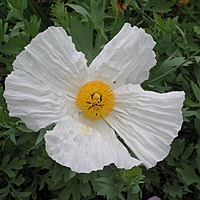How did your garden fare last winter?
The current preoccupation with gardeners still seems to be whether or not the winter killed our precious plants. Last month I urged caution – plants may still start to shoot from the base and could do so well into the summer so patience may reward you. Having said that, the 2010/11 winter was the coldest for 100 years. So with global warming being the hot topic (no pun intended) it’s not surprising if we were lulled into a false sense of security and so planted out that hibiscus, phormium, myrtle or agapanthus last autumn. So what can we do to avoid the same thing happening next winter? You could try:
• Lightening the soil with grit or compost. Cold, wet and heavy soils are more likely to kill tender plants than drier, sandier soil;
• Planting tender plants early, as soon as frosts are over if you can. That way they will get their roots deep in the soil and established before the killer cold arrives;
• Mulch well in autumn – I actually got my Gunneras, Agapanthus and Romneya through last winter with a good, thick cover;
• Choosing plants that look tender and exotic but are actually hardy – ferns and hostas for example;
• Taking cuttings in summer and keeping them frost free over the winter. Many of us do it with geraniums, but it works with a variety of plants such as penstemons and salvias.
If I sound smug, I can reassure you that we have lost hebes, our precious Wollemi pine and at least one acer.
With the garden open on the afternoons of 1 and 2 of May, panic has set in and a weeding operation is in full force. The difference between last year when we opened late April 2010 and now is huge – the garden looks quite different , I would guess it is about 3 or 4 weeks further forward. This means that some of my carefully chosen bulbs that I planted in Autumn 2009 for a good late spring display may be over, but other treasures such as some early perennials and the wisteria should be out. So if you came last year, don’t assume it will look the same! We are offering home-made teas courtesy of friends of South Wolds School this year, and I have a big plant stall.
Talking of tender perennials, we have just returned from a holiday in Spain. Having seen gorgeous tender choyisias, bourganviliia, plumbago and large flowered jasmine plants thriving in their natural, more or less permanently frost free environments, I do wonder if it may be best to stick to the huge range of plants we can grow successfully in the Midlands of England. But hey, where would be the challenge in that?!
